
|
Sale 80
June Pre Long Beach Sale
| Denarii Collection - Roman Republic |
| |
| |
| Lot |
Photo |
Description |
Realized |
Lot 3000 |
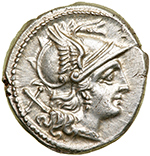 |
Anonymous. Silver Denarius (4.36 g), 207 BC. Rome. Head of Roma right, wearing winged helmet ornamented with griffin's head; behind, X (denomination) Reverse : ROMA in relief in linear frame below, the Dioscuri on horseback riding right, each holding couched spear; above, crescent. Crawford 57/2; Sydenham 219; RSC 20i. Lustrous and well centered. Nearly Mint State.
Estimated Value $400 - 500.
View details and enlarged photos
| Realized
$693 |
Lot 3001 |
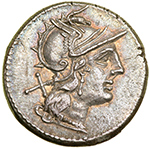 |
Anonymous. Silver Denarius (3.47 g), 194-190 BC. Rome. Head of Roma right, wearing winged helmet ornamented with griffin's head; behind, X (denomination). Reverse : ROMA in relief in linear frame below, the Dioscuri on horseback riding right, each holding couched spear; above, crescent. Crawford 137/1; Sydenham 314; RSC 20i. Perfectly centered with attractive pastel iridescent toning. Superb Extremely Fine.
Estimated Value $600 - 700.
Ex NAC 61 (5-6 October 2011), 604.
View details and enlarged photos
| Realized
$1,175 |
Lot 3002 |
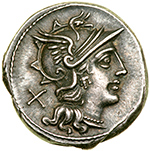 |
Pinarius Natta. Silver Denarius (3.95 g), 155 BC. Rome. Head of Roma right, wearing winged helmet ornamented with griffin's head; behind, X (denomination). Reverse : NA-T below, ROMA in relief in linear frame in exergue, Victory, holding whip and reins, driving galloping biga right. Crawford 200/1; Sydenham 382; Pinaria 2. Well struck and perfectly centered. Nicely toned with golden iridescense on the reverse. Superb Extremely Fine.
Estimated Value $400 - 500.
Ex Roma IV (30 September 2012), 451.
View details and enlarged photos
| Realized
$1,293 |
Lot 3003 |
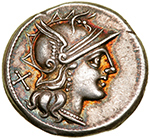 |
C. Scribonius. Silver Denarius (3.89 g), 154 BC. Rome. Head of Roma right, wearing winged helmet ornamented with griffin's head; behind, X (denomination). Reverse : C SCR below, ROMA in relief in linear frame in exergue, the Dioscuri on horseback riding right, each holding couched spear. Crawford 201/1; Sydenham 380; Scribonia 1. Well centered and attractively toned with traces of reddish iridescense. Extremely Fine.
Estimated Value $400 - 500.
Ex Roma IV (30 September 2012), 449.
View details and enlarged photos
| Realized
$1,087 |
Lot 3004 |
 |
Spurius Afranius. Silver Denarius (3.79 g), 150 BC. Rome. Head of Roma right, wearing winged helmet ornamented with griffin's head; behind, X (denomination). Reverse : S AFRA below, ROMA in relief in linear frame in exergue, Victory, holding whip and reins, driving galloping biga right. Crawford 206/1; Sydenham 388; Afrania 1. Well centered and lustrous. Mint State.
Estimated Value $500 - 600.
View details and enlarged photos
| Realized
$793 |
Lot 3005 |
 |
Q. Marcius Libo. Silver Denarius (4.06 g), 148 BC. Rome. LIBO behind, head of Roma right, wearing winged helmet ornamented with griffin's head; below chin, X (denomination). Reverse : Q (MA)RC below, ROMA in relief in linear frame in exergue, the Dioscuri on horseback riding right, each holding couched spear. Crawford 215/1; Sydenham 395; Marcia 1. Boldly struck on a large flan, well centered and lightly toned. Superb Extremely Fine.
Estimated Value $500 - 600.
Ex Roma II (2 October 2011), 398.
View details and enlarged photos
| Realized
$1,586 |
Lot 3006 |
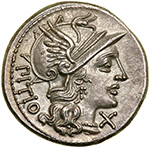 |
L. Sempronius Pitio. Silver Denarius (3.54 g), 148 BC. Rome. PITIO behind, head of Roma right, wearing winged helmet ornamented with griffin's head; below chin, X (denomination). Reverse : L SEM[P] below, ROMA in relief in linear frame in exergue, the Dioscuri on horseback riding right, each holding couched spear. Crawford 216/1; Sydenham 402; Sempronia 2. A superb specimen, needle sharp and perfectly centered; all lightly toned. Mint State.
Estimated Value $1,000 - 1,200.
Ex NAC 61 (5-6 October 2011), 922.
View details and enlarged photos
| Realized
$2,585 |
Lot 3007 |
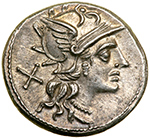 |
Anonymous. Silver Denarius (4.09 g), 143 BC. Rome. Head of Roma right, wearing winged helmet ornamented with griffin's head; behind, X (denomination). Reverse : ROMA in exergue, Diana, holding torch and reins, driving galloping biga of stags right; below, crescent below. Crawford 222/1; Sydenham 438; RSC 101. Well struck, perfectly centered and lightly toned. Nearly Mint State.
Estimated Value $800 - 900.
Ex NAC 61 (5-6 October 2011), 942.
View details and enlarged photos
| Realized
$1,528 |
Lot 3008 |
 |
C. Serveilius M.f. Silver Denarius (3.9 g), 136 BC. Rome. ROMA below, head of Roma right, wearing winged helmet ornamented with griffin's head; behind, wreath and denomination. Reverse : [CS] ERVEIL M F in exergue, the Dioscuri riding in opposite directions, heads turned to face one another, each holding couched spear. Crawford 239/1; Sydenham 525; Servilia 1. Lustrous and untoned, perfectly centered. Nearly Mint State.
Estimated Value $900 - 1,000.
Ex Gemini IX (8 January 2012), 240.
View details and enlarged photos
| Realized
$1,351 |
Lot 3009 |
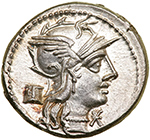 |
M. Marcius Mn.f. Silver Denarius (3.93 g), 134 BC. Rome. Head of Roma right, wearing winged helmet ornamented with griffin's head; behind, modius; below chin, denomination. Reverse : M (MAR)-C / RO-MA in two lines below, Victory, holding whip and reins, driving galloping biga right; below, two wheat ears dividing legend. Crawford 245/1; Sydenham 500; Marcia 8. Well struck, perfectly centered and lustrous. A touch of delicate golden toning adds to its appeal. Mint State.
Estimated Value $800 - 900.
Ex Nomisma 37 (4 October 2008), 96.
View details and enlarged photos
| Realized
$1,087 |
Lot 3010 |
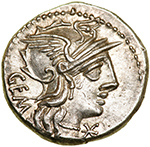 |
M. Aburius M.f. Geminus. Silver Denarius (3.9 g), 132 BC. Rome. GEM behind, head of Roma right, wearing winged helmet ornamented with griffin's head; below chin, denomination. Reverse : M (AB)(VR)I below, ROMA in exergue, Sol, holding whip and reins, driving galloping quadriga right. Crawford 250/1; Sydenham 487; Aburia 6. Lustrous and well centered. Mint State.
Estimated Value $1,000 - 1,200.
Ex Gorny & Mosch 190 (11 October 2010), 422.
View details and enlarged photos
| Realized
$2,468 |
Lot 3011 |
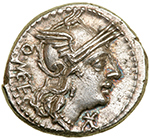 |
Q. Caecilius Metellus. Silver Denarius (3.89 g), 130 BC. Rome. Q (ME)(TEL) behind, head of Roma right, wearing winged helmet ornamented with griffin's head; below chin, denomination. Reverse : ROMA in exergue, Jupiter, holding thunderbolt, reins and branch, driving slow quadriga right. Crawford 256/1; Sydenham 509; Caecilia 21. Boldly struck and well centered. Traces of luster present and lightly toned. Superb Extremely Fine.
Estimated Value $600 - 700.
View details and enlarged photos
| Realized
$969 |
Lot 3012 |
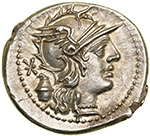 |
C. Cassius. Silver Denarius (3.98 g), 126 BC. Rome. Head of Roma right, wearing winged helmet ornamented with griffin's head; behind, denomination above voting urn. Reverse : C CASSI below, ROMA in exergue, Libertas, holding pileus, scepter and reins, driving galloping quadriga right. Crawford 266/1; Sydenham 502; Cassia 1. Well struck and superb. Traces of luster and delicately toned. Nearly Mint State.
Estimated Value $800 - 900.
Sternberg XXXII (28 October 1996), 172.
View details and enlarged photos
| Realized
$1,175 |
Lot 3013 |
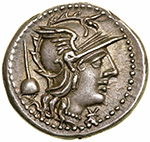 |
T. Quinctius Flaminius. Silver Denarius (3.97 g), 126 BC. Rome. Head of Roma right, wearing winged helmet ornamented with griffin's head; behind, flamen's cap; below chin, denomination. Reverse : T Q below, ROMA in exergue, the Dioscuri on horseback galloping right, each holding spear and shield; below, Macedonian shield. Crawford 267/1; Sydenham 505; Quinctia 2. Boldly struck and perfectly centered, all attractively toned. Superb Extremely Fine.
Estimated Value $1,000 - 1,500.
Ex Roma II (2 October 2011), 409; Goodman Collection (CNG 43, 24 September 1997), 1602; Swiss Bank 33 (22 September 1993), 499.
View details and enlarged photos
| Realized
$2,820 |
Lot 3014 |
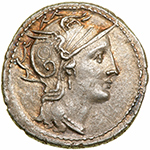 |
C. Claudius Pulcher. Silver Denarius (3.94 g), 110-109 BC. Rome. Head of Roma right, wearing winged helmet ornamented with griffin's head and circular decoration on bowl. Reverse : C PVLCHER in exergue, Victory, holding reins, driving galloping biga right. Crawford 300/1; Sydenham 569; Claudia 1. Finely detailed, delicately toned and perfectly centered. A superb example thus quite rare. Nearly Mint State.
Estimated Value $700 - 800.
Ex Nomisma 37 (4 October 2008), 77.
View details and enlarged photos
| Realized
$617 |
Lot 3015 |
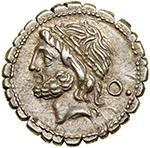 |
L. Scipio Asiagenus. Silver Denarius (3.89 g), 106 BC. Rome. Laureate head of Jupiter left; in right field, O and pellet. Reverse : L SCIP ASIAG in exergue, Jupiter, holding scepter and reins, and hurling thunderbolt, driving galloping quadriga right. Crawford 311/1a; Sydenham 576; Cornelia 24b. Fine serrated edges. Well struck and perfectly centered, all delicately toned. Superb Extremely Fine.
The reverse records the decisive victory over Antiochos III the Great of Syria in 190 BC by the moneyer's ancestor, L. Cornelius Scipio, and his ancestor's brother, Scipio Africanus, at the Battle of Magnesia. The victory resulted in Roman control over the internal affairs of much of Asia Minor, greatly adding to the domains administered directly by Rome and bringing her one step closer to total dominance of the entire Mediterranean region.
In his later career, this moneyer become co-consul with C. Norbanus in 83 BC, and raised two armies to oppose Sulla during the Second Civil War. He was no match for the wily dictator and his hardened legions, however; both of his armies deserted him, defecting to Sulla, without ever committing to battle.
Estimated Value $1,000 - 1,200.
Ex Triton XV (3-4 January 2012), 1467; Tkalec (27 February 2008), 45.
View details and enlarged photos
| Realized
$1,234 |
Lot 3016 |
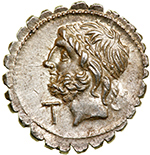 |
L. Scipio Asiagenus. Silver Denarius (3.89 g), 106 BC. Rome. Laureate head of Jupiter left; in left field below chin, T. Reverse : L SCIP ASIAG in exergue, Jupiter, holding scepter and reins, and hurling thunderbolt, driving galloping quadriga right. Crawford 311/1b; Sydenham 576a; Cornelia 24c. Well struck and finely detailed. Lustrous surfaces and lightly toned. A superb example thus quite scarce. Nearly Mint State.
Estimated Value $600 - 700.
Ex Tkalec (8 September 2008), 56.
View details and enlarged photos
| Realized
$1,645 |
Lot 3017 |
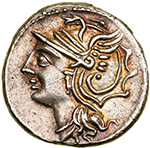 |
Lucius Appuleius Saturninus. Silver Denarius (4.00 g), 104 BC. Rome. Head of Roma left, wearing winged helmet ornamented with griffin's head. Reverse : L SATVRN in exergue, Saturn driving galloping quadriga right; above, pellet and T. Crawford 317/3a; Sydenham 578; Appuleia 1 var. Perfectly centered and delicately toned. Superb Extremely Fine.
Estimated Value $500 - 600.
Ex Roma V (23 March 2013), 527.
View details and enlarged photos
| Realized
$940 |
Lot 3018 |
 |
C. Coelius Caldus. Silver Denarius (3.91 g), 104 BC. Rome. Head of Roma left, wearing winged helmet ornamented with griffin's head. Reverse : C COIL below, CALD in exergue, Victory, holding reins, driving galloping biga left; above X with two pellets. Crawford 318/1a; Sydenham 582; Coelia 2. Boldly struck in high relief and well centered on a nice wide flan. Superb Extremely Fine.
The control mark on the reverse of the denarii of C. Coelius Caldus consists of a Latin letter either alone or with up to four pellets. No control is found on more than one die.
Estimated Value $1,000 - 1,300.
Ex LHS 100 (23-24 April 2007), 384.
View details and enlarged photos
| Realized
$2,468 |
Lot 3019 |
 |
Q. Thermus M.f. Silver Denarius (3.91 g), 103 BC. Rome. Head of Mars left, wearing crested helmet ornamented with plume on side. Reverse : Q (THE)RM M F in exergue, Roman and barbarian soldiers fighting, each holding forth a shield and raising a sword, the Roman soldier on the left protecting a fallen comrade. Crawford 319/1; Sydenham 592; Minucia 19. Well struck and well centered with attractive light multi-color toning. Superb Extremely Fine.
It is likely that the reverse alludes to a specific event of martial prowess of one of the moneyer's ancestors, but if so the precise details have been lost to us. Perhaps it relates to Quintus Minucius Thermus, consul in 193 BC, who, according to Livy, distinguished himself fighting the Ligurians: "Before the consul Lucius Quinctius arrived in his province, Quintus Minucius, in the neighborhood of Pisa, met the Ligures in a pitched battle; he killed nine thousand of the enemy, routed and put to flight the rest and drove them into their camp" (Livy XXXV, 21.7-8). However, he was not awarded a triumph by the Senate for this campaign, although earlier he had received one for fighting the Iberians near Turdo in Spain.
Estimated Value $1,000 - 1,200.
Ex Heritage 3019 (4 April 2012), 23256; M&M Deutschland 9 (4-5 October 2001), 438.
View details and enlarged photos
| Realized
$1,998 |
Lot 3020 |
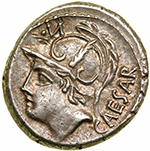 |
L. Julius L.f. Caesar. Silver Denarius (3.97 g), 103 BC. Rome. CAESAR behind, head of Mars left, wearing crested helmet ornamented with plume on side; above, pellet and N (retrograde). Reverse : L IVLI L F in exergue, Venus Genetrix, holding scepter and reins, driving biga of Cupids left; before, lyre; above, pellet and N (retrograde). Crawford 320/1; Sydenham 593a; Julia 4a. Well centered and delicately toned. Superb Extremely Fine.
Similar to the control for the denarius of C. Coelius Caldus above, the controls found on the denarii of L. Julius L.f. Caesar are the letters of the Latin alphabet (only through S) either alone or found accompanied by one or two pellets. The same control mark that is found on the obverse invariably appears on the reverse also, and no pair of controls has more than one pair of dies.
Estimated Value $800 - 900.
Ex NAC 73 (18 November 2013), 83; Sternberg XXII (20 November 1989), 190.
View details and enlarged photos
| Realized
$1,410 |
Lot 3021 |
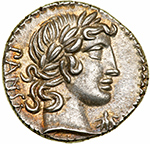 |
C. Vibius C.f. Pansa. Silver Denarius (3.99 g), 90 BC. Rome. PANSA behind, laureate head of Apollo right; below chin, uncertain symbol. Reverse : C VIBIVS C F in exergue, Minerva, holding trophy, reins and spear, driving galloping quadriga right. Crawford 342/5b; Sydenham 684; Vibia 2d. Well struck and perfectly centered. Delicate golden luster. Superb Extremely Fine.
The are several distinct varieties of the denarii of C. Vibius C.f. Pansa. On those with the quadriga reverse, Crawford types 342/4 and 342/5, there are two varieties, with and without Victory flying above. Crawford notes that the figure of Victory on Pansa's coinage presumably reflects Roman successes during the Social War.
Estimated Value $500 - 600.
Ex Tkalec (29 February 2008), 95.
View details and enlarged photos
| Realized
$999 |
Lot 3022 |
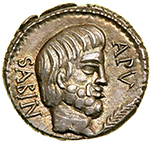 |
L. Titurius L.f. Sabinus. Silver Denarius (3.9 g), 89 BC. Rome. SABIN behind, bare head of King Tatius right; before, A PV; below chin, palm branch. Reverse : [L] TITVRI in exergue, Tarpeia, facing, buried to her waist in shields, with raised hands she tries to thrust off two soldiers who are about to cast their shields onto her; above, star in crescent. Crawford 344/2c; Sydenham 699a; Tituria 5. Attractively toned. Superb Extremely Fine.
The story of Tarpeia as depicted on this coin was well-known in ancient Rome, and is recounted by Livy: "The last of these wars was commenced by the Sabines and proved the most serious of all… Spurius Tarpeius was in command of the Roman citadel. Whilst his daughter had gone outside the fortifications to fetch water for some religious ceremonies, Tatius bribed her to admit his troops within the citadel. Once admitted, they crushed her to death beneath their shields, either that the citadel might appear to have been taken by assault, or that her example might be left as a warning that no faith should be kept with traitors. A further story runs that the Sabines were in the habit of wearing heavy gold armlets on their left arms and richly jeweled rings, and that the girl made them promise to give her 'what they had on their left arms,' accordingly they piled their shields upon her instead of golden gifts. Some say that in bargaining for what they had in their left hands, she expressly asked for their shields, and being suspected of wishing to betray them, fell a victim to her own bargain" (Livy I, 11.5-9). Tarpeia's body was then hurled from a steep cliff on the southern summit of the Capitoline Hill, and the Tarpeian Rock, as it became known subsequently, was where notorious traitors were executed in ancient Rome.
The head of Titus Tatius, king of the Sabines, relates to the Sabine origin of the moneyer's gens. On one variety of this type, in place of the palm branch which alludes to Roman successes in the Social War, is found a TA monogram, identifying the head as that of King Tatius. A most unusual feature of the obverse is the addition of the letters A PV (argentum publicum), meaning that the issue was struck by metal owned by the Roman state. Noting that a particular coinage was struck by state-owned metal is not without precedent, and in fact it occurs on coins of eight different moneyers during the Republican period. However, it seems unnecessary: presumably all official coinage was made from metal owned by the Roman state, and its significance here is not readily apparent.
Estimated Value $800 - 900.
Ex William C. Boyd Collection (Baldwin's 42, 26 September 2005), 39 with Boyd's original collection ticket showing that he purchased the coin from Spink in 1889.
View details and enlarged photos
| Realized
$1,763 |
Lot 3023 |
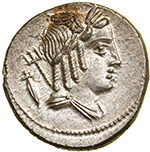 |
L. Julius Bursio. Silver Denarius (3.9 g), 85 BC. Rome. Draped bust of Apollo Vejovis right, wearing winged laurel wreath; behind, trident and tanner's knife. Reverse : L IVLI BVRSIO in exergue, Victory, holding wreath and reins, driving galloping quadriga right; above, XXXXV. Crawford 352/1c; De Ruyter dies 153/XXXV; Sydenham 728b; Julia 5a. Lustrous and lightly toned. Mint State.
Estimated Value $500 - 600.
Ex Tkalec (7 May 2009), 92.
View details and enlarged photos
| Realized
$823 |
Lot 3024 |
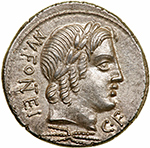 |
Mn. Fonteius C.f. Silver Denarius (4.20 g), 85 BC. Rome. (MN) FO(NT)EI behind, C F below chin, laureate head of Vejovis right; below, thunderbolt. Reverse : Infant Genius seated on goat right; above, pilei of the Dioscuri; in exergue, filleted thyrsus; all within laurel wreath. Crawford 353/1c; Sydenham 724a; Fonteia 10. Lustrous and lightly toned. Nearly Mint State.
The moneyer is perhaps the brother of the moneyer M. Fonteius (see Crawford 347) and not inconceivably the tribune featured on the reverse of Crawford 429/1 (see the coin of P. Fonteius P.f. Capito below).
The reverse recalls that the god Jupiter was suckled by the she-goat Amaltheia on Mt. Ida during his infancy, and depicts a statue that was within the Temple of Vejovis in Rome.
Estimated Value $1,000 - 1,200.
Ex Tkalec (29 February 2008), 106.
View details and enlarged photos
| Realized
$2,350 |
Lot 3025 |
 |
Q. Antonius Balbus. Silver Denarius (4.01 g), 83-82 BC. Rome. S C behind, laureate head of Jupiter right; below A and pellet. Reverse : Q (ANT)O B(AL)B / PR in two lines in exergue, Victory, holding wreath and palm, driving galloping quadriga right. Crawford 364/1c; Sydenham 742b; Antonia 1. A boldly struck example, perfectly centered. Lustrous and lightly toned. Nearly Mint State.
Q. Antonius Balbus was a Marian loyalist who was appointed praetor in Sardinia in 82 B.C. The obverse marking S C shows the issue was struck ex senatus consulto, that is, by special decree of the Senate, and presumably forms part of the preparations to resist the return of Sulla. Balbus was subsequently defeated at his post in Sardinia by Sulla's legate, L. Philippus, and died in the battle.
Estimated Value $700 - 800.
Ex Elsen 106 (11 September 2010), 301.
View details and enlarged photos
| Realized
$1,175 |
Lot 3026 |
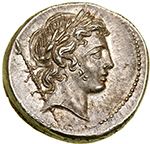 |
P. Crepusius. Silver Denarius (4.06 g), 82 BC. Rome. Laureate head of Apollo right, scepter at shoulder. Reverse : P CREPVSI in exergue, Soldier on horse rearing right, hurling spear; behind, V. Crawford 361/1a; Sydenham -; Crepusia 1c. Needle sharp, lustrous and delicately toned. A superb example. Nearly Mint State.
The moneyer's family is little known, and the moneyer himself is only know from his coins. This issue of denarii was quite massive, however, with controls numbers reaching DXX. According to Crawford, the control numerals on the reverse form a continuous sequence with no control-numeral having more than one die. Crawford 361/1a, the only variety without obverse control, is extremely rare while the rest of P. Crepusius' denarii are all quite common.
Estimated Value $1,200 - 1,400.
Ex Tkalec (29 February 2008), 114.
View details and enlarged photos
| Realized
$2,233 |
Lot 3027 |
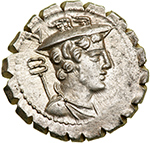 |
C. Mamilius C.f. Limetanus. Silver Denarius (3.81 g), 82 BC. Rome. Draped bust of Mercury right, wearing winged petasus; behind, A above caduceus. Reverse : MAMIL LIME(TA)N, Ulysses advancing right, holding staff and extending hand to his dog Argus, coming to greet him. Crawford 362/1; Sydenham 741; Mamilia 6. Mostly well struck on a nice large flan. Although a trifle soft at the borders from 3 to 6 o'clcock an on the corresponding portion of the reverse, the central features are amazing. Lustrous and lightly toned. Nearly Mint State.
The types on this coin allude to the moneyer's claim to descent from Telegonus, son of Ulysses and Circe, and hence from the god Mercury. The reverse features a sadly endearing scene from the Odyssey, when Odysseus returns home after twenty years disguised as a beggar and his old dog, who had been neglected, recognizes him:
"So they spoke. And a dog, lying there, lifted its head and pricked up its ears. Argus was the hound of noble Odysseus, who had bred him himself, though he sailed to sacred Ilium before he could enjoy his company. Once the young men used to take the dog out after wild goat, deer and hare, but with his master gone he lay neglected by the gate, among the heaps of mule and cattle dung that Odysseus' men would later use to manure the fields. There, plagued by ticks, lay Argus the hound. But suddenly aware of Odysseus' presence, he wagged his tail and flattened his ears, though no longer strong enough to crawl to his master. Odysseus turned his face aside and hiding it from Eumaeus wiped away a tear then quickly said: 'Eumaeus, it's strange indeed to see this dog lying in the dung. He's finely built, but I can't tell if he had speed to match or was only a dog fed from the table, kept by his master for show.'
"Then, Eumaeus, the swineherd, replied: 'Yes this dog belongs to a man who has died far away. If he had the form and vigour he had when Odysseus left for Troy you'd be amazed by the speed and power. He was keen-scented on the trail, and no creature he started in the depths of the densest wood escaped him. But now he is in a sad state, and his master has died far from his own country, and the thoughtless women neglect him. When their masters aren't there to command them, servants don't care about the quality of their work. Far-voiced Zeus takes half the good out of them, the day they become slaves.'
"With this he entered the stately house and walking straight into the hall joined the crowd of noble suitors. As for Argus, seeing Odysseus again in this twentieth year, the hand of dark death seized him" (Homer, Od. XVII.290-327).
Estimated Value $1,000 - 1,200.
Ex Tkalec (27 October 2011), 140.
View details and enlarged photos
| Realized
$1,528 |
Lot 3028 |
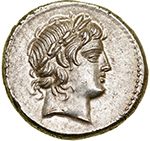 |
L. Censorinus. Silver Denarius (4.06 g), 82 BC. Rome. Laureate head of Apollo right. Reverse : L CENSOR, Satyr standing left, extending arm and holding wine skin over shoulder; behind, statue on column. Crawford 363/1d; Sydenham 737; Marcia 24. Lustrous and lightly toned. Nearly Mint State.
The meaning of the reverse is obscure. Crawford suggests it has to do with the moneyer's nomen but does not elaborate. Marsyas is best known in Greek and Roman mythology for his hubris. He was said to have challenged the god Apollo to a contest playing the flute, the victor getting to decide whatever punishment the loser would receive. Naturally, Apollo won the contest, and and as punishment for daring to challenge a god, he chose to flay Marsyas alive.
Estimated Value $800 - 900.
Ex Tkalec (29 February 2008), 117.
View details and enlarged photos
| Realized
$1,763 |
Lot 3029 |
 |
C. Annius T.f. T.n., with L. Fabius L.f. Hispaniensis. Silver Denarius (3.93 g), 82-81 BC. Uncertain mint in northern Italy. C ANNIA TF TN PRO COS EX S C, diademed and draped bust of Annia Perenna right; behind, winged caduceus; below, X; before, scales. Reverse : L FABI L F HISP in exergue, Victory, holding palm and reins, driving galloping quadriga right; above horses, Q. Crawford 366/1b; Sydenham 748a; Annia 2b. Unusually well struck and perfectly centered. Lustrous and lightly toned. Nearly Mint State.
Like the lot of Q. Antonius Balbus, the obverse markings here show that this issue was also struck ex senatus consulto. C. Annius was sent by the Senate against Q. Sertorius in Spain and took with him two questors, L. Fabius L.f. Hispaniensis and C. Tarquitius P.f. The fact he took two questors is only intelligible if the Senate had authorized as his province both Spains. The coins with the name of L. Fabius on the reverse were struck in northern Italy while still en route to Spain; those with the name C. Tarquitius were struck in Spain. L. Fabius later defected to Sertorius, for which he was proscribed.
Estimated Value $1,200 - 1,500.
Ex Tkalec (29 February 2008), 119.
View details and enlarged photos
| Realized
$1,763 |
Lot 3030 |
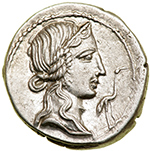 |
Q. Caecilius Metellus Pius. Silver Denarius (3.68 g), 81 BC. Mobile military mint with Sulla's army in northern Italy. Diademed head of Pietas right; to right, stork standing right. Reverse : IMPER, jug and lituus within laurel wreath. Crawford 374/2; Sydenham 750; Caecilia 44. Well struck, well centered and lustrous. Nearly Mint State.
Q. Caecilius Metellus Pius came from one of the most important and wealthiest families of Rome. Beginning in the 3rd century BC, his family held numerous consulships, tribunates, censorships and military commands. His father, Q. Caecilius Metellus Numidicus, was the chief commander in the Jugurthine War in Numidia until Marius displaced him, and was later censor until driven into exile by Marius. The obverse of this coin portrays the goddess Pietas and alludes to the moneyer's cognomen, Pius. The moneyer acquired the honorable title from the people of Rome, whom he had beseeched in order to secure the restoration from exile of his father. The reverse probably refers to an unattested augurate of the moneyer's father, but may also allude to Sulla's holding of the augurate in ca. 82 BC (cf. Crawford p. 374).
Estimated Value $1,500 - 2,000.
Ex Nomos 5 (25 October 2011), 219.
View details and enlarged photos
| Realized
$1,410 |
Lot 3031 |
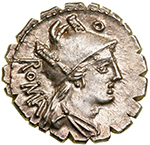 |
C. Poblicius Q.f. Silver Denarius (3.65 g), 80 BC. Rome. ROMA behind, draped bust of Roma right, wearing Phrygian helmet ornamented with plumes on sides; above, O. Reverse : C POBLICI Q F, Hercules standing left, strangling the Nemean lion; between his feet, club; in left field, bow and quiver; above, O. Crawford 380/1; Sydenham 768; Poblicia 9. Boldly struck, well centered and lustrous, all delicately toned. Mint State.
Although the moneyer is unattested except for his coins, his family is well known for having built the small Aventine road, the Clivus Poblicius, as well as the temple of Flora, whose games they instituted in 241 BC. The types chosen by the moneyer for his coins should probably be viewed in light of Sulla's victories, but possibly there is a family connection as well. The reverse type showing Hercules strangling the Nemean lion may allude to the moneyer's family origins at Cora, where there was a famous temple to Hercules, and from Cora even further back to Argos and the valley of Nemea where Hercules killed the lion. The Phrygian helmet worn by Roma seems to be a simple artistic feature, with no further significance other than perhaps reflecting an awareness of Trojan origins.
Estimated Value $1,500 - 2,000.
Ex Künker 174 (9 September 2010), 534.
View details and enlarged photos
| Realized
$2,350 |
Lot 3032 |
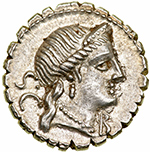 |
C. Naevius Balbus. Silver Denarius (3.81 g), 79 BC. Rome. S C behind, diademed head of Venus right; before, B. Reverse : C N(AE) B(AL)B in exergue, Victory, holding reins, driving galloping triga right. Crawford 382/1a; Sydenham 769; Naevia 6b. Well struck, perfectly centered and lustrous. Nearly Mint State.
The moneyer is unattested other than on this special coinage authorized by senatorial decree (ex senatus consulto), which should most probably be viewed as another issue to finance operations in the the Sertorian War in Spain. The triga depicted on the reverse is most interesting. At the time this coin was struck it was already an archaic convention, Homeric in origin, originally borrowed from the Greeks and used in Rome only during the ludi Romani, the games celebrating the Roman victory at Lake Regillus. It appears only one other time during the Republican period, on coins struck 111-110 BC under the moneyers Appius Claudius Pulcher, T. Manlius Mancius, and Q. Urbinius.
Estimated Value $500 - 600.
Ex Tkalec (27 October 2011), 143.
View details and enlarged photos
| Realized
$940 |
Lot 3033 |
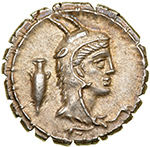 |
L. Papius. Silver Denarius (4.00 g), 79 BC. Rome. Head of Juno Sospita right, wearing goat's skin headdress; behind, amphora. Reverse : L PAPI in exergue, griffin springing right; below, hydria. Crawford 384/1 (symbols 2); Sydenham 773; Papia 1. Boldly struck and perfectly centered. Rare symbol. Amazing detail throughout and delicately toned. Superb Extremely Fine.
Although the moneyer is unknown except for his coins, the coins are very popular with collectors for the interesting controls they display, which according to Crawford "are no more than a random selection of pairs of everyday objects" (p. 399). Papius used two related symbols, one on the obverse die, the other on the reverse, to keep track of production and to control losses amongst the slaves at the mint. Each pair of controls only has one set of dies. On this particular coin the paired symbols are an amphora and a hydria, both related to wine, the amphora for storage and the hydria for mixing wine with water (unlike barbarians with the uncouth habit of consuming it undiluted, the Romans and Greeks always drank their wine mixed with water, often with the addition of spices or honey for flavoring).
Estimated Value $1,500 - 2,000.
Ex Triton XV (3-4 January 2012), 1472.
View details and enlarged photos
| Realized
$3,643 |
Lot 3034 |
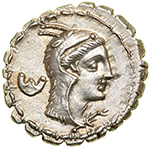 |
L. Papius. Silver Denarius (4.01 g), 79 BC. Rome. Head of Juno Sospita right, wearing goat's skin headdress; behind, pelta. Reverse : L PAPI in exergue, griffin springing right; below, axe. Crawford 384/1 (symbols 121); Sydenham 773; Papia 1. Boldly struck and lustrous. Another amazing example. Nearly Mint State.
The Romans were masters of most branches of craft and technology, and the symbols on this coin of L. Papius were specialized tools used in the tanning industry: the pelta, a sort of scraper-knife, and the axe. Leather was of course an everyday necessity for the Romans. While the purpose which these tools had is probably not readily apparent to most of us today, it was surely obvious to any Roman who held this coin.
Estimated Value $1,000 - 1,500.
Ex Tkalec (8 September 2008), 122.
View details and enlarged photos
| Realized
$2,056 |
Lot 3035 |
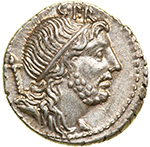 |
Cn. Lentulus. Silver Denarius (4.01 g), 74 BC. Uncertain mint in Spain. G P R above, diademed and draped bust of the Genius of the Roman People right, scepter over shoulder. Reverse : CN LEN Q in exergue, EX S C across field, scepter, globe, and rudder. Crawford 393/1a; Sydenham 752; Cornelia 54. Boldly struck and lustrous with delicate golden toning. Nearly Mint State.
Here we follow Harlan's revised dating to 74 BC as opposed to Crawford's 76 BC for this issue (see M. Harlan, Roman Republican Moneyers and Their Coins, 81 BCE-64 BCE, 2012, pp. 83-91). The revised date is based on the slight down-dating of the terminus of the Roncofreddo hoard as evidenced by the Mesagne hoard, Cn. Lentulus' own cursus honorem which makes a date for this issue in 75 too early, and most importantly a letter from Pompey to the Senate in Rome requesting money to pay his troops.
The letter from Pompey was recorded by Sallust (2.98), and was read before the Senate in January of 74. In it, Pompey states that he had already exhausted his own (considerable) personal resources and even gone into debt supporting his troops, yet they had only been paid for one year of service while they had already served for three. He threatened that if the Senate did not provide the necessary funds to pay his troops he would not only be unable to pursue the war against Sertorius, but that he would likely lose control of his legions and the war could be brought to Italy itself. With these dire warnings, the Senate found the money to pay Pompey's troops, authorizing Cn. Lentulus, ex senatus consulto, to strike the coins.
The year following this issue Cn. Lentulus struck an identical issue employing the same designs but with the unusual legend LENT CVR x FL, Curator denariorum flandorum. He did so because he was no longer quaestor with the responsibility of issuing coins to pay the troops, nor for that matter was he even a mint magistrate (thus the designation III VIR would not apply either), yet he was still responsible for making sure there was sufficient specie to finance military operations. We do not know if this title was official and had come from the Senate in Rome or if Lentulus merely invented the title to indicate his responsibility.
Estimated Value $600 - 700.
Ex NAC 51 (5 March 2009), 31; NAC 33 (6 April 2006), 257.
View details and enlarged photos
| Realized
$793 |
Lot 3036 |
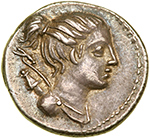 |
C. Postumius At.? or Ta.? Silver Denarius (3.8 g), 73 BC. Rome. Draped bust of Diana right, hair tied into knot at back of head, bow and quiver at shoulder. Reverse : C POSTVMI / (TA) or (AT), hound running right; below, spear. Crawford 394/1a; Sydenham 785; Postumia 9. Well struck and nicely centered, all toned. Extremely Fine.
It is possible that the monogram found in the exergue of the reverse on this coin may resolve as Tatius. On coins of both L. Titurius Sabinus and T. Vettius Sabinus the same monogram occurs in conjunction with the head of the Sabine king, Tatius, but the surname TA or AT is otherwise unknown for the Postumia gens. It is possible that the Postumii, undoubtedly one of Rome's most ancient families, claimed descent from the Sabine king.
Estimated Value $700 - 800.
Ex Goldberg 59 (1-2 June 2010), 2319; Frederick H. Rindge Collection, pt. I (Malter XXIX, 22 March 1985), 489.
View details and enlarged photos
| Realized
$1,293 |
Lot 3037 |
 |
Q. Fufius Calenus and M. Cordus. Silver Denarius (3.80 g), 68 BC. Rome. HO behind, VI(RT) before, KALENI below, conjoined heads of Honos, laureate, and Virtus, wearing crested helmet, right. Reverse : CORDI in exergue (ITAL) to left, RO to right, Italia standing right, holding cornucopiae, clasping hands with Roma standing left, foot on globe, holding scepter; in left field, winged caduceus. Crawford 403/1; Sydenham 797; Fufia 1. Well struck with the obverse in high relief. A lustrous example and delicately toned. Mint State.
Most interpretations of the types on this coin relate the obverse depiction of Honos and Virtus with the reverse design showing reconciliation between Rome and Italy. Grueber even goes as far as to place this reconciliation under the tutelage of the gods Honos and Virtus, which of course on the surface seems entirely appropriate. However, there is another possible interpretation of the types that is espoused by Harlan, one which requires considering the obverse and reverse in isolation from one another. From this point of view, Calenus, whose design appears on the obverse, selected a type which was reflective of his Marian sympathies and popularis politics (in his later career Calenus became a popularis politician closely aligned with Caesar). Gaius Marius had dedicated a temple to Honos and Virtus after his conquest of the Cimbri in 101 BC, and of all his monuments it was the only one to survive destruction under Sulla. During the years since Sulla's dictatorship, anything remotely related to Marius was considered taboo, and it was only early in 69 BC when Caesar gave a public funeral oration for his aunt Julia, who was the widow of Marius, that attitudes began to change regarding the deceased political reformer.
The identification of the moneyer whose name CORDI appears on the reverse of this coin is debated. He is normally identified as Mucius Cordus Scaevola, but this seems unlikely as Scaevola acquired his cognomen for performing a daring act of bravery, and it would therefore be natural to use that name instead of CORDI. More plausible is that the moneyer is one Manius Cordius Rufus of Tusculum, the father of the Caesarian moneyer Manius Cordius of 46 BC. This supposes that he identified with the popularis political philosophy of his colleague, Calenus, and also better relates to the reverse in that he was a novus homo (new man) in Roman politics, having come from a municipia that benefitted from Roman citizenship following the Social War.
Estimated Value $1,500 - 2,000.
Ex LHS 100 (23-24 April 2007), 396.
View details and enlarged photos
| Realized
$3,055 |
Lot 3038 |
 |
M. Plaetorius M.f. Cestianus. Silver Denarius (3.99 g), 68-67 BC. Rome. CESTIANVS, head of Cybele right; behind, forepart of lion; below chin, globe. Reverse : unlisted control mark, M PLAETORIVS AED CVR EX S C, curule chair; in left field, c. Crawford 409/2; Sydenham 808; Plaetoria 3. Well struck on a large size flan with delicate iridescent toning on both sides. Superb Extremely Fine.
Although Hersh and Walker dated this issue to 57 BC based on their interpretation of the evidence from the Mesagne hoard, they failed to note that the dates of Cestianus' curule aedileship are secured by Cicero's speech, Pro Cluentio, which was read in 66 BC. Cicero says in his speech that he had argued the case of Decimus Matrinius, a man who had been degraded to a lower order by the censors of 70 BC, before the curule aediles Cestianus and Flaminius. This secures their aedileship to between 70 and 67 BC, and for other reasons Cestianus could not have been curule aedile in either 70 or 69 BC.
The types of this coin refer to the Ludi Megalesiaci, games which honored the goddess Cybele, and were presented by the curule aediles.
For further discussion for his moneyer's coin types, see the lot with the non-AED CVR denarius below.
Estimated Value $700 - 800.
Ex Kirk Davis List 54 (October 2008), 45; William C. Boyd Collection, with Boyd's original collection ticket showing that he purchased the coin from Spink in 1891.
View details and enlarged photos
| Realized
$2,115 |
Lot 3039 |
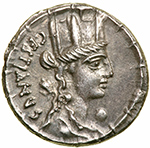 |
M. Plaetorius M.f. Cestianus. Silver Denarius (3.65 g), 68-67 BC. Rome. CESTIANVS, head of Cybele right; behind, forepart of lion; below chin, globe. Reverse : M PLAETORIVS AED CVR EX S C, curule chair; in left field, rudder. Crawford 409/2; Sydenham 808; Plaetoria 3. Boldly struck and perfectly centered. A superb example and delicately toned. Nearly Mint State.
Estimated Value $700 - 800.
Ex Tkalec (27 October 2011), 149.
View details and enlarged photos
| Realized
$1,293 |
Lot 3040 |
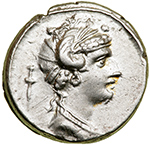 |
M. Plaetorius M.f. Cestianus. Silver Denarius (3.91 g), 67 BC. Uncertain mint. Draped female bust right, with hair in bag or net; behind, dagger. Reverse : M PLAETORI CEST EX S C, winged caduceus. Crawford 405/3b; Sydenham 805; Plaetoria 6. Well struck and nicely centered, lustrous. Nearly Mint State.
This moneyer's coinage of seven distinct types falls into two groups, the first group with two types having the legend AED CVR EX S C showing that Cestianus struck those coins while curule aedile in either 68 or 67 BC, and five types that are special issues authorized by the Senate and employ the legend EX S C (ex senatus consulto). This latter group, from which this coin comes, was dated by Crawford and others to 67 BC, but Hersh and Walker reassigned them to 57 BC based on the fact that the Mesagne hoard contained no examples. However, the five types in question show marked stylistic differences, which indicates that each was either struck at a separate officinae with different workmen involved in engraving the dies, or, a more reasonable assumption, that they were struck at different mints altogether. Additionally, all employ control marks, a feature that saw its heyday in the 70s and early 60s.
In the early 60s BC, there was a significant pirate menace in the Mediterranean. Rome was at special risk as it imported most of its food from outside of Italy, and the pirates were causing prices to skyrocket. After previous attempts to confront the problem had proved ineffectual, legislation was passed assigning command to combat the pirates to Pompey, giving him extraordinary command over the entire Mediterranean Sea. He was allowed to recruit as many troops as he thought necessary, and he did so, raising 120,000 infantry, 5,000 cavalry, and a sizable fleet of 500 ships. The money to pay for this massive buildup - according to Appian 6000 Attic talents (24,000,000 denarii) - was authorized by senatorial decree.
Pompey divided his command into thirteen districts, assigning each a fleet under the command of a legate. He kept for himself a fleet of sixty ships, with which he toured the various districts. His first efforts were concentrated in the western Mediterranean, and in a mere forty days he eliminated the pirate menace there. He then went on to the eastern Mediterranean and quickly subdued the remaining pirates, many of whom had settled in southern Asia Minor at a distance from the coast.
It is in light of these events that Cestianu's non-AED CVR types should be seen. Pompey needed someone familiar with minting operations to coin the 6000 talents decreed by the Senate to pay for extraordinary command, and Cestianus, who had just served as curule aedile with authority to strike coins, fit the mold perfectly. Additionally, it is logical to assume that he would have traveled throughout the thirteen districts seeing to the monetary needs of each fleet, which would explain not only the divergent styles of his five EX S C types, but their complete absence from the Mesagne hoard. Finally, this resolves the question of symbols reappearing on coins in the 50s. For these reasons Cestianus' non-AED CVR denarii should be assigned a date of 67 BC, not 57 BC as proposed by Hersh and Walker.
Estimated Value $1,000 - 1,400.
Gemini V (6 January 2009), 235.
View details and enlarged photos
| Realized
$1,175 |
Lot 3041 |
 |
Mn. Aquillius Mn.f. Mn.n. Silver Denarius (3.8 g), 65 BC. Rome. III VIR behind, VIRTVS before, helmeted and draped bust of Virtus right. Reverse : (MN) AQVIL (MN) F (MN) N, SICIL in exergue, the consul Mn. Aquillius standing left, head right, raising a prostrate Sicilia before him, and holding shield. Crawford 401/1; Sydenham 798; Aquillia 2. Well struck on a nice large flan and lustrous. Mint State.
The types on this handsome denarius recall the virtue of the moneyer's grandfather, Manius Aquillius, who diligently quelled the slave revolt in Sicily (104-101 BC) that had defied three earlier governors. In 104 BC, the consul Marius took command in Gaul to subdue the Cimbri and Teutones, and the Senate granted him permission to request troops from Rome's allies so that he might pursue the war. When he asked Nikomedes of Bithynia for troops, the king responded that he had none to spare as most of his men had been seized by Roman tax farmers as slaves. The Senate then decreed that no citizen of allied states could be held in slavery to serve in Rome's provinces, and instructed the praetors to see to their liberation.
In Sicily, the Roman governor P. Licinius Nerva freed about 800 slaves, but then a group of influential landowners and wealthy elites convinced the governor to desist. The slaves who had not yet been freed stole away from the farms in open revolt. Licinius initially pursued these slaves and inflicted a serious defeat upon them, but when he failed to follow up his victory this emboldened other slaves in the province and the revolt quickly escalated. Soon there was a slave army of 40,000 ravaging the province, inflicting serious defeates on Roman forces sent to pursue them.
All this changed in 101 BC with the arrival of the moneyer's ancestor, the governor Manius Aquillius. He quickly wore down the slave army, reducing their strongholds to rubble and killing many. He defeated their leader in single combat in a notable battle, although he himself suffered a serious head wound. After recovering, he quickly mopped up further resistance and pacified the province.
Estimated Value $1,000 - 1,300.
Ex Ponterio 145 (11-12 January 2008), 253.
View details and enlarged photos
| Realized
$1,410 |
Lot 3042 |
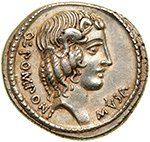 |
Q. Pomponius Musa. Silver Denarius (4.01 g), 65 BC. Rome. Q POMPONI MVSA, laureate head of Apollo right. Reverse : HERCVLES MVSA RVM, Hercules Musagetes standing right, draped with lion's skin, playing lyre, club resting against leg. Crawford 410/1; Sydenham 810; Pomponia 8. An incredible example! Struck on a broad flan, well centered and of artistic style. Superb Extremely Fine.
Hersh and Walker date Q. Pomponius Musa's coins to 56 BC based on the fact that none of his coins appeared in the Mesagne hoard, which they dated to 58 BC. However, Musa's coins are uncommon, with Crawford estimating that no type had more than ten reverse dies. The period 57-54 BC saw massive outputs by the moneyers in Rome, and additionally even Hersh and Walker recognized there was difficulty with their arrangement in squeezing in an additional twenty-three moneyers during the period from 58-51 BC. Thus it appears illogical that we should be looking in the mid 50s for an unnecessary and rare issue of coins; a date in the mid 60s would be more appropriate. While the date is not secure, there is one additional piece of evidence that suggests an earlier date for Musa's coins. This is the appearance of the apex, an accent mark above the V in MVSA, indicating a long vowel. The only other instance of its use during the Republic is on the coins of L. Furius Cn.f. Brocchus, whom Harlan dates to 64 BC (see M. Harlan, Roman Republican Moneyers and Their Coins, 81 BCE-64 BCE, 2012, pp. 206-208; in his earlier study Harlan had dated Brocchus to 63 BC).
Estimated Value $5,000 - 6,000.
View details and enlarged photos
| Realized
$11,750 |
Lot 3043 |
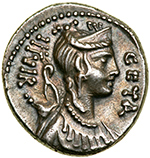 |
C. Hosidius C.f. Geta. Silver Denarius (3.85 g), 64 BC. Rome. GETA before, III VIR behind, diademed and draped bust of Diana right, bow and quiver at shoulder. Reverse : C HOSIDI C F, the wild board of Calydon charging right, side pierced by arrow, harried by hound below. Crawford 407/2; Sydenham 903; Hosidia 1. Boldly struck in high relief with attractive iridescent toning. Superb Extremely Fine.
The classical myth of the Calydonian boar served to illustrate the need for paying proper respect to the gods and the consequences for not doing so. King Oeneus of Aetolia had forgotten to accord proper rites to the goddess Diana (Artemis), and for this sacrilege she sent a chthonic beast, the wild boar of Calydon, to ravage the Aetolian hinterland. The boar was the bane of the people, destroying vineyards and crops and forcing everyone to take shelter behind their city walls. With starvation ensuing, a hunt was organized, and most of the illustrious heroes of Greece's heroic age took part (with the exception of Hercules who fought his own chthonic beast, the Erymanthean boar). Amongst all these male heroes was one female, the heroine Atalanta, and she won the signal honor of being the first to wound the boar, having pierced its side with an arrow. For this she was awarded its hide. Although the precise meaning is lost to us, it can be assumed that Hosidius employed the type of the Caledonian boar to illustrate a claimed descent from one of the heroes involved in the hunt, perhaps from Atalanta herself.
Estimated Value $900 - 1,100.
Ex Meister & Sonntag 6 (1 October 2008), 201.
View details and enlarged photos
| Realized
$1,116 |
Lot 3044 |
 |
L. Furius Cn.f. Brocchus. Silver Denarius (4.0g), 64 BC. Rome. III VIR across field, BROCCHI below, bust of Ceres right, wreathed with grain ears, between wheat ear and barley corn. Reverse : L FVRI / CN F in two lines above, curule chair between fasces. Crawford 414/1; Sydenham 902; Furia 23. Well struck on a nice broad flan and lustrous. Nearly Mint State.
The obverse possibly relates to a family history where an ancestor served as aedile of the grain supply, the cura annonae, or it may just reflect the moneyer's populist political philosophy. At the time this coin was struck, Catiline's conspiracy was secretly developing, only to be exposed and crushed the following year during Cicero's consulship. Although grain shortage was not one of the social causes of the Catiline conspiracy as outlined by Cicero - remember that Pompey had cleared the Mediterranean of the pirate menace in the early 60s BC and thus the grain supply had been secured - after the revelation of the plot, Cato proposed a grain measure extending the dole to include Rome's poor. Obviously, then, even though supply was plentiful, it was a source of discontent for the many urban plebs who were not benefitting from free distribution, and perhaps it was this mood that Brocchus was attempting to exploit by his choice of types on this coin.
Estimated Value $700 - 800.
Ex Tkalec (8 September 2008), 154.
View details and enlarged photos
| Realized
$823 |
Lot 3045 |
 |
L. Aemilius Lepidus Paullus. Silver Denarius (4.1g), 62 BC. Rome. PAVLLVS LEPIDVS behind and above, CONCORDIA before, diademed and veiled head of Concordia right. Reverse : TER above, PAVLLVS in exergue, the consul, L. Aemilius Paullus, togate, on right standing left, erecting trophy; to left, the Macedonian king, Perseus, and his two sons standing right. Crawford 415/1; Sydenham 926; Aemilia 10. Boldly struck with complete legends, lustrous surfaces and nicely toned. Superb Extremely Fine.
The Hellenistic state of Macedonia ended along with the Third Macedonian War in 168 BC when the moneyer's ancestor and namesake, the consul Lucius Aemilius Paullus, defeated King Perseus of Macedon at Pydna. Prior to Aemilius Paullus' arrival, only Perseus' persistent lack of military intelligence prevented a total rout of the Roman legions as the prior consuls were inept and totally unworthy of the task. Aemilius Paullus, however, was an experienced commander, having seen service in the Hanniballic Wars. After Macedon's defeat, Paullus conquered Epirus, laying waste numerous towns and taking as many as 150,000 prisoners to supply Rome's slave markets. For his magnificent conquests the Senate awarded him the title Macedonicus along with a splendid triumph.
Estimated Value $700 - 800.
View details and enlarged photos
| Realized
$1,293 |
Lot 3046 |
 |
L. Scribonius Libo. Silver Denarius (3.78 g), 62 BC. Rome. BON EVENT before, LIBO behind, diademed head of Bonus Eventus right. Reverse : PVTEAL above, SCRIBON in exergue, garlanded well-head decorated with two lyres and anvil. Crawford 416/1c; Sydenham 928; Scribonia 8b. A mangificent strike and perfectly centered. Lustrous surfaces overlaid with delicate russet toning. A fantastic example and perhaps the finest known. Superb Mint State.
The reverse depicts the puteal Scribonianum (Scribonian well-head) which had been set up by a distant ancestor of the moneyer. The well-head was quite ornate, being either festooned with garlands or, more likely, engraved with their likeness, and was located near the arch of the Fabii in the Roman Forum. The type comes in three varieties, with either a pair of tongs, a hammer, or an anvil set at the base of the well-head (the last, of which our coin is a wonderfully pleasing example, is by far the scarcest of the three). Built upon a bidental, a spot that had been struck by lightening, the puteal Scribonianum served as an important meeting place for litigants and moneylenders in Rome as it was conveniently located near the praetor's tribunal. The obverse is appropriately dedicated to the deity Bonus Eventus, the bringer of good outcomes, who appealed equally to all parties involved in any legal dispute.
Estimated Value $3,000 - 4,000.
Ex NAC 63 (17 May 2012), 278; NAC 9 (16 April 1996), 703.
View details and enlarged photos
| Realized
$6,463 |
Lot 3047 |
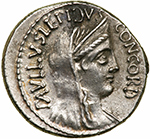 |
L. Aemilius Lepidus Paullus and L. Scribonius Libo. Silver Denarius (4.84 g), 62 BC. Rome. PAVLLVS LEPIDVS behind and above, CONCORD before, diademed and veiled head of Concordia right. Reverse : PVTEAL SCRIBON above, LIBO in exergue, garlanded well-head decorated with two lyres and hammer. Crawford 417/1a; Sydenham 927; Aemilia 11. Boldly struck, lustrous and lightly toned. Superb Extremely Fine.
Estimated Value $700 - 800.
Ex Tkalec (27 October 2011), 152.
View details and enlarged photos
| Realized
$646 |
Lot 3048 |
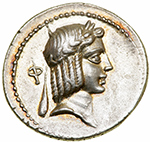 |
C. Calpurnius Piso L.f. Frugi. Silver Denarius (3.83 g), 61 BC. Rome. Laureate head of Apollo right; behind, Φ. Reverse : C PISO L F FRVG, nude horseman wearing conical hat galloping right; above, sword. Crawford 408/1a (dies 33/1038); Hersh 89 (O33/R1038); Sydenham 846; Calpurnia 24j. Boldly struck in high relief and lustrous. A superb example. Nearly Mint State.
A collector could spend a lifetime assembling the many varieties and various symbol combinations of the coins of C. Calpurnius Piso L.f. Frugi, and even then it is doubtful whether he would ever near completion. The types of Apollo and racing horseman refer to the Apolline Games first instituted in 212 BC under the moneyer's ancestor, P. Cornelius Sulla. The moneyer later became quaestor in 58 BC, but is perhaps most known as the husband of Tullia, the beloved daughter of the famous orator and statesman, Cicero.
Estimated Value $900 - 1,000.
Ex LHS 100 (23-24 April 2007), 398; NAC 10 (9 April 1997), 515.
View details and enlarged photos
| Realized
$1,645 |
Lot 3049 |
 |
C. Calpurnius Piso L.f. Frugi. Silver Denarius (3.90 g), 61 BC. Rome. Filleted head of Apollo right; behind, human ear. Reverse : C PISO L F FRVGI, nude winged horseman wearing conical hat galloping left, holding torch; above, EN. Crawford 408/1b (dies 114/142); Hersh 375 (O281/R3004); Sydenham 874; Calpurnia 24c. Boldly struck in very high relief, lustrous and lightly toned. Nearly Mint State.
Estimated Value $600 - 700.
Ex Hunter Collection (Goldberg 72, 5 February 2013), 4399.
View details and enlarged photos
| Realized
$1,058 |
|
|